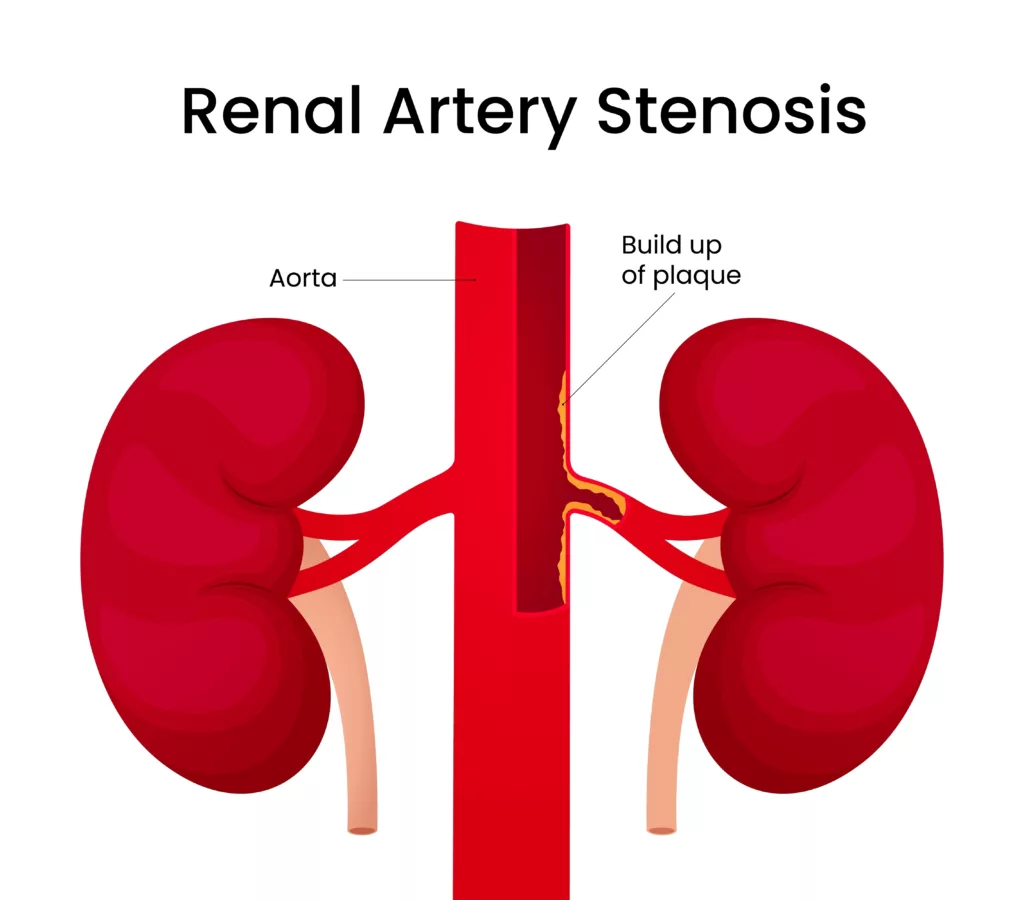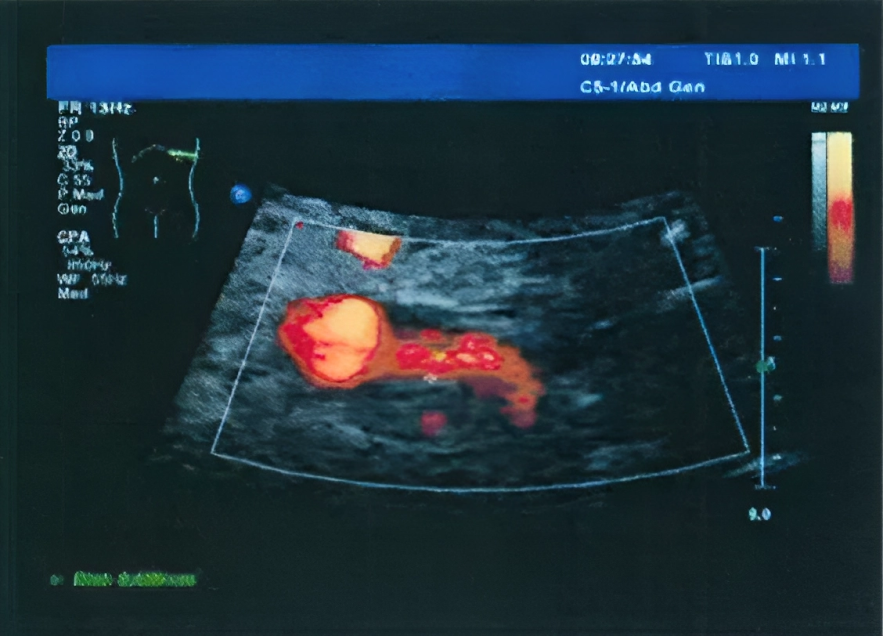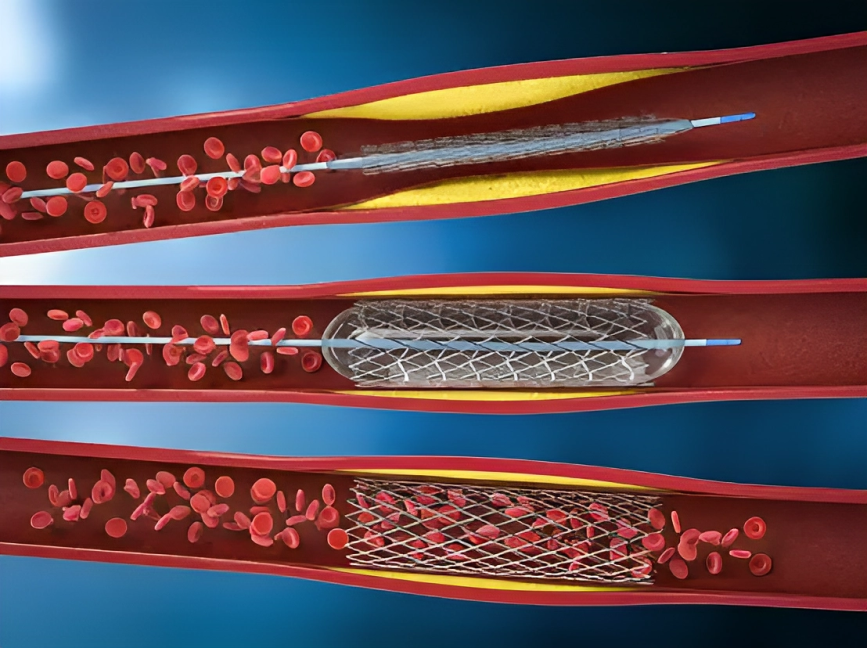What is Renal Artery Stenosis?
As words suggest, renal arteries mean vessels of kidneys, and stenosis means narrowing. Renal artery stenosis is defined as the narrowing of the vessels that supply blood to your kidneys. It is one the prime culprits of secondary renovascular hypertension, with an estimated prevalence of 1-10 percent in the 50 million population of the United States of America (USA).
Renal arteries provide vascular supply to your kidneys. Arteries carry blood toward the kidneys, while renal veins carry blood away from the kidneys. However, some diseases affect your renal vascular supply. Renal artery stenosis is one of the vascular diseases that affect your kidneys. It can be unilateral or bilateral.1Facp, B. S. S. M. (n.d.). Renal Artery Stenosis Treatment & Management: approach considerations, surgical care, consultations.https://emedicine.medscape.com/article/245023-treatment#d82Bokhari, M. R. (2023, July 17). Renal artery stenosis. StatPearls – NCBI Bookshelf. https://www.ncbi.nlm.nih.gov/books/NBK430718/

Epidemiology
According to some studies, it was noted that the prevalence of this disease is less than 1 percent in patients with mild hypertension. While the prevalence rate is high (10-40 percent) in patients with acute, refractory, or severe and chronic hypertension. According to some studies, ischemic nephropathy is considered the main cause (5-22 %) of advanced kidney diseases.3Bokhari, M. R. (2023, July 17). Renal artery stenosis. StatPearls – NCBI Bookshelf. https://www.ncbi.nlm.nih.gov/books/NBK430718/
Pathophysiology
Atherosclerosis (building up of cholesterol and fatty substances inside the vessels) is the main cause of renal artery stenosis, but the mechanism of injury is unclear. However, some contributing factors can cause endothelial injury (injury to vessels). These factors are hypertension, smoking, alcoholism, diabetes Mellitus type 1 and type 2, dyslipidemia infections (viral or bacterial), and an increase in homocysteine levels due to exaggerated immune response.
Increased cholesterol levels in your body may cause atherosclerotic changes (formation of lesions) in your vessels. Atherosclerotic lesions boost the proliferation of endothelial cells and smooth muscles, which increases the permeability of the affected vessels for low-density lipoproteins (LDL) and macrophage, resulting in plaque formation. Therefore, these plaques cause stenosis or narrowing of the affected vessels.
Your kidney is one of the most important organs in your body, performing multiple functions. The blood flow to your kidney is greater than the other organs’ perfusion (blood flow) because it drives your filtration process. However, the glomerular filtration rate is directly proportional to the blood flow. If renal blood flow is maximum, GFR is maximum, and vice versa.
Adaptive Changes in Renal Vasculature
Renal artery stenosis causes ischemia in the affected vessels, resulting in reduced blood to the kidney and GFR drops.4Bokhari, M. R. (2023, July 17). Renal artery stenosis. StatPearls – NCBI Bookshelf. https://www.ncbi.nlm.nih.gov/books/NBK430718/ Additionally, due to renal artery stenosis, kidneys show adaptive changes according to the blood supply. These changes include:
- Atrophic changes in the affected kidney
- Inflammation and fibrosis
- Thickening of the bowman’s capsule
- Thickening of the affected vessels
- Renin secretion
Renin is an enzyme secreted from the juxtamedullary apparatus. This enzyme plays a homeostatic role in the kidney. It helps in the conversion of angiotensinogen into angiotensin 1, which is then converted into angiotensin 2 with the help of angiotensin convertase enzyme (ACE). In addition, Angiotensin 2 is a potent vasoconstrictor and aldosterone activator that causes the retention of sodium and water, resulting in secondary hypertension.5Weber, B., & Dieter, R. S. (2014). Renal artery stenosis: epidemiology and treatment. International Journal of Nephrology and Renovascular Disease, 169. https://doi.org/10.2147/ijnrd.s40175
Unilateral Renal Artery Stenosis
In this type, only one kidney is involved, while the other remains normal. The affected kidney’s perfusion is reduced, activating renin, angiotensin 1, and angiotensin 2, resulting in angiotensin-dependent hypertension.
Moreover, the normal kidney’s perfusion is increased, which suppresses the renin-angiotensin system, resulting in pressure natriuresis (increased sodium excretion in the urine).
Bilateral Renal Artery Stenosis
In this type of stenosis, both kidneys are involved. The perfusion of both kidneys is decreased, impairing the sodium and water excretion. Moreover, it results in volume expansion, leading to arterial hypertension (Angiotensin independent).6EPOS™ (n.d.). https://epos.myesr.org/posterimage/esr/ecr2013/116828/mediagallery/507241
Causes of Renal Artery Stenosis
There can be various causes of renal artery stenosis. But the following are the two most common causes of renal artery stenosis:
Atherosclerosis
Atherosclerosis is the most common cause of renal artery stenosis and accounts for 60-90% of cases. Moreover, it most commonly affects men over the age of 45 years and involves the proximal part of the main renal artery.
Fibromuscular Dysplasia
Fibromuscular dysplasia is the least common (about 10-30 %) cause of renal artery stenosis. It most commonly affects younger women over 50 and usually involves the middle and distal parts of the main renal artery.
Other Causes
Other less common causes of renal artery stenosis are:
- Vasculitis (inflammation of the vessels like Buerger disease, polyarteritis nodosa, and Takayasu arteritis).
- Arterial dissection
- Thromboembolism
- Fibrosis
Risk Factors of Renal Artery Stenosis?
There are multiple risk factors that contribute to causing renal artery stenosis. These risk factors are :
- Hypertension (High blood pressure)
- Hyperlipidemia (Increase low-density lipoprotein level)
- Chronic diabetes
- Lack of physical activity
- Obesity
- Smoking
- Age
- Positive family history
Symptoms of Renal Artery Stenosis
There are various presentations of renal artery stenosis. Sometimes, it remains asymptomatic until it becomes more severe. The clinical presentations of RAS are:
- Severe hypertension or increased blood pressure (secondary)
- Change in serum creatinine level
- Pulmonary edema (collection of fluid inside the lungs)
- Heart failure
- Hypokalemia
- Increase blood urea nitrogen level (BUN)
- Proteinuria
- Decrease glomerular filtration rate
- Weight loss
- Insomnia
- Nausea and vomiting
- Loss of appetite
- Muscle aches
How to Diagnose Renal Artery Stenosis?
Diagnosis of renal artery stenosis can be confirmed in various ways.
History
History is the first and most important step in reaching the diagnosis of every disease. Your doctor will ask some questions. These are:
- Do you have pain in your flank?
- Do you have normal urine output?
- Do you have an appetite?
- Medical history
- Family history
Physical Examination
In physical examination, different examination points are taken into consideration. Your doctor will:
- Check signs of anemia
- Check for renal and abdominal bruit
- Palpate abdomen
- Palpate bother kidneys
- Check blood pressure
- Auscultate the back of the chest to check for any crepitation (Signs of heart failure)
- Signs of edema
- Temperature changes and tenderness
- Check for lymphadenopathy (swelling of lymph nodes)
Laboratory Investigation
Some laboratory investigations are required to assess the renal function. These investigations include:
- Serum creatinine level to asses the glomerular filtration rate of the kidney.
- Urine examination to check for red blood cells and pus cells.
- 24-hour urine output record.
- Antinuclear antibodies test and anti-cytoplasmic antibodies test to rule out other autoimmune diseases like lupus erythematosus and vasculitis.
Other Tests
Other tests that are used to support your diagnosis and to rule out other diseases are:
- Complete blood count (CBC) with Erythrocyte sedimentation rate (ESR)
- C reactive protein analysis (CRP)
- Viral markers
- Renal parameters
- Renal function test
- Serum electrolytes
Radiological Investigations
Radiological investigations are required when the clinical scenario fulfills the following criteria:
- When there is a confirmation of secondary arterial hypertension rather than primary hypertension.
- Suggestive laboratory findings confirm renal function abnormality.
There are multiple radiological investigations that are used to evaluate renal artery stenosis; the Gold standard is renal angiography. However, there are a variety of other investigations that can support the diagnosis. Radiological Investigations include the following:
X-Ray KUB ( kidney & Urinary Bladder):
X-ray is the first investigation of choice to rule out other causes such as kidney stones, bladder stones, size of the kidney, and renal anomalies.
Duplex Doppler Ultrasonography (USG):
It is a non-invasive, less expensive, and easily available procedure that assesses renal function. However, its result is operator-dependent and has variable sensitivity. There are two approaches to detecting renal artery stenosis. These are:
1. Direct Visualization of Renal Vessels
In this approach, direct visualization of the main renal artery with color Doppler ultrasound is assessed, followed by spectrum analysis (to assess renal artery flow) by using an anterior or anterolateral approach. Moreover, it shows the anatomy of both kidneys, the size of the kidneys, and the complete examination of the renovascular supply in 50-90% of the cases. There are four criteria that are used to diagnose proximal stenosis:
- Increase in systolic pressure of the renal artery (100 cm/sec to 200 cm/sec)
- Renal to aortic systolic velocity ratio greater than 3.5.
- Turbulent flow followed by stenotic site
- Renal artery visualization without any Doppler signal.
2. Infra-renal Doppler Waveform
This approach visualizes different parts of the kidneys via the trans lumbar approach. In this procedure, the clinical criteria for diagnosis are:
- Acceleration should be less than 370-470 cm/sec.
- The resistive index between the right and left kidneys should be greater than 5%.
- The presence of pulsus Tardus (damping of waves).
- The early systolic peak is absent in the renal artery stenosis.

CT Angiography:
CT angiography is a radiological intervention in which an iodinated contrast is injected intravenously, obtaining a three-dimensional image of the renal vasculature. It is a very specific and sensitive method of visualizing renal arteries to diagnose renal artery stenosis. However, it is not suitable for patients with a previous history of chronic kidney disease.
MR Angiography:
This is a non-invasive test that provides the anatomy of renal vessels and also gives physiological information about the kidney without any iodinated contrast. Besides this, MR angiography provides the following information:
- Anatomy of the renal vascular tree
- Blood flow rate
- Renal perfusion rate
- Glomerular filtration rate
- Measurement of renal size and renal volume
According to some studies, MR angiography provides limited information. It can diagnose only proximal 3 to 3.5 cm renal artery stenosis and does not reveal information about the distal and segmental renal arteries. Additionally, contraindications include patients with metals, heart pacemakers, metallic devices inside the eyes, or other metallic implants.
Treatment of Renal Artery Stenosis
It is a serious illness that requires prompt treatment to avoid serious side effects. Treatment of renal artery stenosis is based on medical treatment and surgical treatment.
How to Approach it?
Treatment of renal artery stenosis depends upon the degree of stenosis and the functioning of the kidneys.7Facp, B. S. S. M. (n.d.). Renal Artery Stenosis Treatment & Management: approach considerations, surgical care, consultations. https://emedicine.medscape.com/article/245023-treatment#d8 When the kidney doesn’t function normally, your nephrologist recommends revascularization therapy. However, revascularization is the treatment of choice when the degree of stenosis exceeds 80-85%.
On the other hand, when the degree of stenosis is about 50-80% or less than 50%, then observation has more benefits than revascularization.
Medical approach
Medical interventions control hypertension and other risk factors. Therefore, different medicines can treat this condition. These include the following:
- Angiotensin convertase enzyme inhibitors (ACE) or angiotensin receptor blockers (ARBs) help control high blood pressure. Moreover, monitoring serum potassium and serum creatinine levels is critical, as this medicine causes hyperkalemia and increases serum creatinine levels.
- Calcium channel blockers are replacers of ACE inhibitors and ARBs.
- Statins help to lower body cholesterol levels.
- Low-dose aspirin in atherosclerotic disease
Surgical approach
The surgical approach is preferable for patients who do not respond to medical therapy. Surgical interventions are considered in patients :
- Who are young (less than 40 years of age)
- When antihypertensive drugs do not control blood pressure
- Those who have a positive history of pulmonary edema and have positive clinical findings
- When renal function is compromised
Revascularization:
Surgical revascularization is a technique to restore kidney function.
Criteria for revascularization:
- Serum creatinine level should be less than 4 mg/dl.
- The degree of stenosis should be greater than 80%.
- Increase in serum creatinine level after ACE inhibitor administration.
Angioplasty:
Angioplasty is a surgical procedure that opens blocked renal arteries. It is a very effective method for treating atheromatous lesions associated with arterial hypertension.
In this technique, your doctor inserts a camera-guided catheter into the body through blood vessels on the narrowing side, with a balloon attached to the catheter site. When the balloon is inflated, the artery dilates.

Nephrectomy:
Nephrectomy is a surgical procedure to remove one or both kidneys. However, your nephrologist advises it when the size of the affected kidney is reduced and renal function drops to zero.
Lifestyle Modification
Some modifiable risk factors can help prevent renal artery stenosis.8Lifestyle changes for renal artery stenosis. (n.d.). NYU Langone Health. https://nyulangone.org/conditions/renal-artery-stenosis/treatments/lifestyle-changes-for-renal-artery-sten By adopting a lifestyle modification, you can avoid this condition. These are:
- Avoid salty foods because these foods boost your blood pressure
- Exercise regularly
- Reduce stress and anxiety
- Control diabetes
- Good sleep pattern
- Avoid smoking
Conclusion
To conclude, renal artery stenosis is the narrowing of renal arteries. It is more likely to occur due to atherosclerosis. High lipid levels, high blood pressure, diabetes, and obesity are the risk factors for it. Medications such as ARBs and ACE inhibitors, statins, and low-dose aspirin are effective treatments for atherosclerotic disease. If medical treatment fails, your doctor will opt for surgical management.
Refrences
- 1Facp, B. S. S. M. (n.d.). Renal Artery Stenosis Treatment & Management: approach considerations, surgical care, consultations.https://emedicine.medscape.com/article/245023-treatment#d8
- 2Bokhari, M. R. (2023, July 17). Renal artery stenosis. StatPearls – NCBI Bookshelf. https://www.ncbi.nlm.nih.gov/books/NBK430718/
- 3Bokhari, M. R. (2023, July 17). Renal artery stenosis. StatPearls – NCBI Bookshelf. https://www.ncbi.nlm.nih.gov/books/NBK430718/
- 4Bokhari, M. R. (2023, July 17). Renal artery stenosis. StatPearls – NCBI Bookshelf. https://www.ncbi.nlm.nih.gov/books/NBK430718/
- 5Weber, B., & Dieter, R. S. (2014). Renal artery stenosis: epidemiology and treatment. International Journal of Nephrology and Renovascular Disease, 169. https://doi.org/10.2147/ijnrd.s40175
- 6EPOS™ (n.d.). https://epos.myesr.org/posterimage/esr/ecr2013/116828/mediagallery/507241
- 7Facp, B. S. S. M. (n.d.). Renal Artery Stenosis Treatment & Management: approach considerations, surgical care, consultations. https://emedicine.medscape.com/article/245023-treatment#d8
- 8Lifestyle changes for renal artery stenosis. (n.d.). NYU Langone Health. https://nyulangone.org/conditions/renal-artery-stenosis/treatments/lifestyle-changes-for-renal-artery-sten

